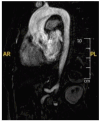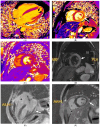The Role of Cardiovascular Magnetic Resonance Imaging in Athletic Individuals-A Narrative Review
- PMID: 40429571
- PMCID: PMC12112729
- DOI: 10.3390/jcm14103576
The Role of Cardiovascular Magnetic Resonance Imaging in Athletic Individuals-A Narrative Review
Abstract
Cardiovascular magnetic resonance imaging (MRI) is an advanced cardiac imaging modality that is often required when evaluating athletic individuals. Unrestricted imaging planes, excellent spatial resolution, and a lack of ionising radiation are some of the benefits of this modality. Cardiac MRI has been established as the gold standard imaging modality for morphological assessment, volumetric analysis, and tissue characterisation. Cardiac MRI without any doubt is an excellent diagnostic tool when evaluating athletes with symptoms or those individuals exhibiting equivocal findings at screening. It is also useful for athletes who fall within the grey zone and is especially important among athletes with a suspected or confirmed diagnosis. Cardiac MRI plays a strategic role when adopting a shared decision-making model in athletes with heart disease, tailoring and personalising medical care to the condition and the athlete's wishes. The aim of this review is to provide a comprehensive yet practical overview of the role of cardiac MRI when evaluating athletes in clinic.
Keywords: athlete; cardiac MRI; cardiomyopathy; fibrosis; sudden cardiac death.
Conflict of interest statement
The authors declare no conflict of interest.
Figures
















Similar articles
-
Cardiac imaging and stress testing asymptomatic athletes to identify those at risk of sudden cardiac death.JACC Cardiovasc Imaging. 2013 Sep;6(9):993-1007. doi: 10.1016/j.jcmg.2013.06.003. JACC Cardiovasc Imaging. 2013. PMID: 24029371 Review.
-
The multi-modality cardiac imaging approach to the Athlete's heart: an expert consensus of the European Association of Cardiovascular Imaging.Eur Heart J Cardiovasc Imaging. 2015 Apr;16(4):353. doi: 10.1093/ehjci/jeu323. Eur Heart J Cardiovasc Imaging. 2015. PMID: 25681828
-
Cardiac Imaging in the Athlete: Shrinking the "Gray Zone".Curr Treat Options Cardiovasc Med. 2020 Feb 3;22(2):5. doi: 10.1007/s11936-020-0802-8. Curr Treat Options Cardiovasc Med. 2020. PMID: 32016641 Review.
-
Advanced cardiac imaging in athlete's heart: unravelling the grey zone between physiologic adaptation and pathology.Radiol Med. 2021 Dec;126(12):1518-1531. doi: 10.1007/s11547-021-01411-2. Epub 2021 Aug 22. Radiol Med. 2021. PMID: 34420142 Free PMC article. Review.
-
The Role of Cardiac Magnetic Resonance Imaging in Distinguishing the Athlete's Heart From Hypertrophic Cardiomyopathy-A Brief Literature Review.Echocardiography. 2024 Nov;41(11):e70021. doi: 10.1111/echo.70021. Echocardiography. 2024. PMID: 39476121 Review.
References
-
- WHO . Guidelines on Physical Activity and Sedentary Behaviour. World Health Organization; Geneva, Switzerland: 2020. [(accessed on 24 January 2025)]. Available online: https://www.ncbi.nlm.nih.gov/books/NBK566046/
-
- Ljungqvist A., Jenoure P.J., Engebretsen L., Alonso J.M., Bahr R., Clough A.F., de Bondt G., Dvorak J., Maloley R., Matheson G., et al. The International Olympic Committee (IOC) Consensus Statement on Periodic Health Evaluation of Elite Athletes, March 2009. Clin. J. Sport Med. 2009;43:631–643. doi: 10.1097/jsm.0b013e3181b7332c. - DOI - PubMed
Publication types
LinkOut - more resources
Full Text Sources

